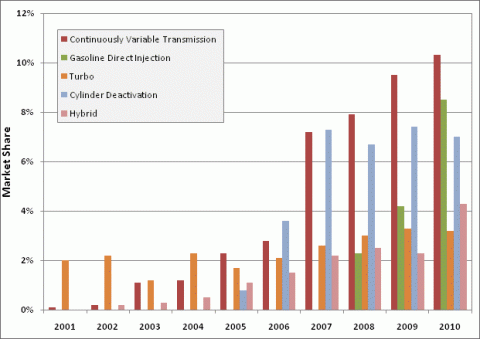Vehicle manufacturers are turning to vehicle technologies to improve efficiency and meet strict fuel economy requirements. Over the last 10 years, the use of engine technologies like multi-valves and variable valve timing have become commonplace while other technologies like gasoline direct injection, cylinder deactivation, hybrid drivetrains and continuously variable transmissions have gained market share, particularly in the last 5 years. Though not a new technology, turbochargers have improved in recent years and manufacturers are increasingly viewing them as a way to meet performance requirements with smaller engines. Ford's popular EcoBoost engines use a combination of turbocharging and gasoline direct injection and there are other manufacturers employing this strategy as well.
Market Share of Selected Vehicle Technologies for Improved Efficiency, 2001-2010
Source: Environmental Protection Agency, Light-Duty Automotive Technology, Carbon Dioxide Emissions, and Fuel Economy Trends: 1975 Through 2010.
Supporting Information
| Technology | 2001 | 2002 | 2003 | 2004 | 2005 | 2006 | 2007 | 2008 | 2009 | 2010 |
|---|---|---|---|---|---|---|---|---|---|---|
| Continuously Variable Transmission | 0.1% | 0.2% | 1.1% | 1.2% | 2.3% | 2.8% | 7.2% | 7.9% | 9.5% | 10.3% |
| Gasoline Direct Injection | 0.0% | 0.0% | 0.0% | 0.0% | 0.0% | 0.0% | 0.0% | 2.3% | 4.2% | 8.5% |
| Turbo | 2.0% | 2.2% | 1.2% | 2.3% | 1.7% | 2.1% | 2.6% | 3.0% | 3.3% | 3.2% |
| Cylinder Deactivation | 0.0% | 0.0% | 0.0% | 0.0% | 0.8% | 3.6% | 7.3% | 6.7% | 7.4% | 7.0% |
| Hybrid | 0.0% | 0.2% | 0.3% | 0.5% | 1.1% | 1.5% | 2.2% | 2.5% | 2.3% | 4.3% |
| Multi-Valve* | 49.0% | 53.3% | 55.5% | 62.3% | 65.6% | 71.7% | 71.7% | 76.4% | 83.6% | 86.1% |
| Variable Valve Timing* | 19.6% | 25.3% | 30.6% | 38.5% | 45.8% | 55.4% | 57.3% | 58.2% | 72.0% | 86.4% |
*Multi-Valve and Variable Valve Timing not graphed. | ||||||||||


